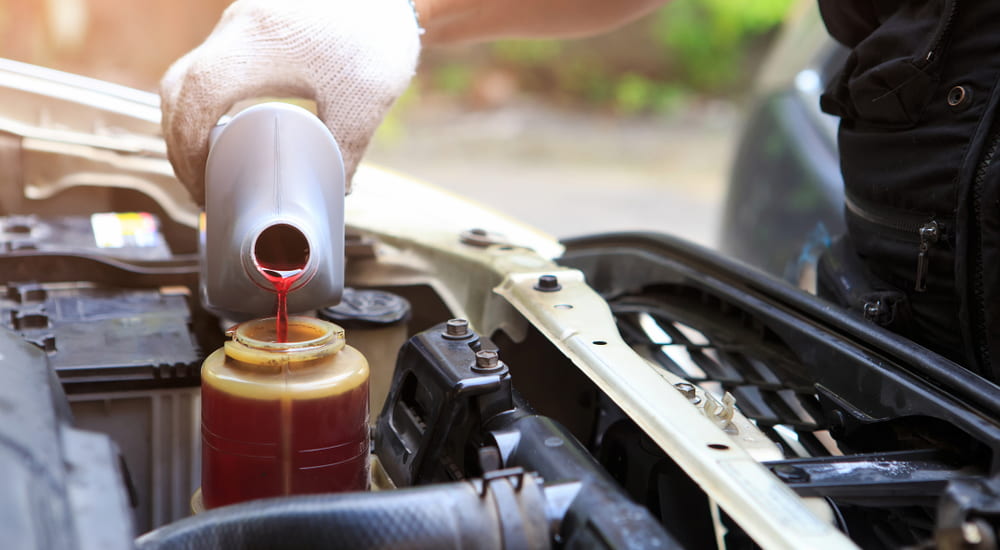Few parts of your car are quite as vital as the transmission. Whether automatic or manual, transmissions are a mainstay of any modern vehicle, enabling the engine to deliver the varying levels of torque needed to accelerate from a stop while also improving efficiency at higher speeds. These complex transmission systems are designed with tight tolerances and are routinely exposed to high temperatures and pressure, which is why transmission fluid should never be treated as an afterthought.
All transmission fluid serves the same general purpose, enabling gear changes while preventing wear on the internal components of a vehicle’s transmission that comes with everyday use. Some transmission fluid also doubles as a hydraulic fluid that allows crucial components like the torque converter, valve body, and clutches to do their thing. The exact composition of the fluid varies depending on the type of transmission it’s designed for, as well as the vehicle manufacturer. Generally speaking, it contains a mix of oil, hydrocarbons, oxidation and rust inhibitors, detergents, antioxidants, and other additives.
Different automakers have developed their own proprietary formulas to provide the exact specifications and properties required for their transmission. It’s important to do a little research before grabbing the first bottle you see at your local auto parts store or to just arm yourself with knowledge before you head down to your local transmission shop. Let’s cover what you need to know about transmission fluid as we take a look at the two main types, review some lesser-known varieties, and learn how proper maintenance and inspection can prove useful when it comes to your transmission’s health.
Automatic Transmission Fluid
The main difference between the fluid used in automatic and manual transmissions comes down to viscosity. Automatic transmission fluid (ATF) is noticeably thinner than manual transmission fluid (MTF) due to the relatively complex design of an automatic transmission. The thicker MTF provides increased protection for the gears and brass synchronizers found in the relatively simple manual transmission. With so many different parts to lubricate, ATF needs to be less viscous in order to flow into every valve and passage of the transmission. The thinner nature of ATF also means it performs better in cold weather.
ATF’s dual role as a hydraulic fluid might represent the biggest difference from MTF. When it’s time to change gears, a solenoid pushes this hydraulic ATF through the valve body to actuate clutches, allowing smooth, seamless transitions. The thin ATF fluid is much better suited for this job than the thicker MTF and is one of the biggest reasons these fluids aren’t interchangeable. Additionally, ATF aids in heat resistance and thermal stability, which prevents the buildup of sludge that can come with extreme temperatures.
Not all ATF is the same, as different automakers have developed their own specialized blends over the years. When it comes to American auto brands, ATFs are typically broken down into three brands. GM vehicles usually call for either Dexron VI or Mercon LV, which are specifically formulated to penetrate the transmission’s tightly packed internal assembly. Many Ford vehicles use Mercon V, while many Chrysler (including Dodge, Jeep, and Ram models) require ATF+4.
Essentially, ATF serves four main purposes:
Hydraulic Fluid: ATF helps to change an automatic transmission’s gear through hydraulic pressure.
Wear: Metal-on-metal contact can significantly impact transmission wear, but that’s where ATF’s lubricating properties come in. ATF forms a fluid film between metal components, protecting the gears and keeping everything running smoothly.
Friction: While ATF is formulated to prevent wear, some friction is required for the clutch pack to perform the necessary shifts. ATF toes the line between providing proper lubrication and ensuring the right amount of friction.
Heat Dissipation: An automatic transmission tends to generate a lot of heat, especially compared to a manual transmission, which is why ATF’s role in heat dissipation is so essential. Some vehicles also employ an additional transmission cooler to help keep the fluid at the ideal temperature.
Manual Transmission Fluid
From color and composition to its specific role in the transmission, MTF is a whole different ball of wax from ATF. Since manual transmissions are built around a much simpler design than their automatic cousins, MTF doesn’t need to be able to flow into deeper, recessed areas. This allows automakers to use a thicker type of fluid, providing a couple of benefits over the thinner fluid found in an automatic. The main advantage is that the high-viscosity MTF is better at providing the correct friction required by a manual transmission while also lubricating the gears, synchronizers, and bearings integral to its operation.
MTF is designed with additives that help it withstand the increased pressure and provide the right friction properties required to ensure accurate gear engagement. It is better at retaining its viscosity over a range of operating conditions, but it does have its downsides. The thicker nature of MTF means it can take a little while to warm up when exposed to low temperatures, which can lead to some slow, sticky shifts when driving on a cold winter morning. (Synthetic fluids can help alleviate this problem.)
Like ATF, MTF comes in several different flavors specific to different manufacturers. GL-5 and GL-4 are two of the most popular formulations. MTF serves three main purposes:
Shifting: A manual transmission relies on a set of synchronizers to do its job. These synchronizers help to equalize the speeds of the engine and transmission between various gears, resulting in smooth shifts. MTF’s viscosity provides these synchronizers with the correct amount of friction needed to cleanly mate the various gears. Using transmission fluid that’s too thin can cause premature engagement of the synchronizer and gear, leading to abrupt shifts and accelerated wear.
Wear: ATF and MTF might differ in a number of important ways, but both play a big part in preventing wear by creating a protective film between metal components.
Protect Brass: The brass synchronizers found in an MTF are rather delicate due to the softer nature of the metal alloy. Using the wrong transmission fluid can damage these brass components, but the right MTF shouldn’t give you any such problems.

Automated Manual Transmission
Automatic and manual transmissions are no longer the only two options on the scene. The automated manual transmission (AMT), which is usually marketed as a Direct Shift Gearbox (“DSG”) or Sequential Manual Gearbox (SMG), is a popular option for some luxury and performance-focused models. These automated manual transmissions offer the best of both worlds, combining the convenience of an automatic with the precise control of a manual with the addition of a button or paddle-based gear selector. AMTs are usually built with a mechanical clutch, but unlike a true manual transmission, this clutch is operated by some sort of automated control, be it electronic, hydraulic, or pneumatic. The fusion of styles used in an AMT requires a special type of transmission fluid due to the dual-clutch gearbox, which is the cornerstone of their design.
Continuously Variable Transmission (CVT)
The continuously variable transmission (CVT) has become an increasingly prevalent design in recent years. These CVTs are similar to automatic transmissions, but instead of gears, they rely on a series of pulleys and belts that provide an endless number of gear ratios. Many drivers appreciate the improved smoothness and fuel efficiency of a CVT, though they are not very well-suited to performance-minded models or those equipped with more powerful engines. CVT fluid increases the transmission’s steel-to-steel friction to prevent belt slippage, which is just one reason why a CVT should always be serviced with the correct fluid for the job.
When to Change Fluid
Keeping on top of your vehicle’s recommended maintenance schedule is the easiest way to ensure consistent performance and longevity. From changing the engine oil and filter to replacing worn-out belts and other engine components, a little maintenance can go a long way toward keeping you on the road. Your vehicle’s transmission is no exception and requires regular inspections and fluid changes in order to perform at its best. The specific maintenance schedule depends on the make, model, and type of transmission. This can be found in your vehicle’s owner’s manual, but here are some general guidelines to keep in mind.
In most cases, a vehicle with an automatic transmission should have its ATF changed every 90,000 miles. For most drivers, that amounts to once every six years, though the schedule might need to be accelerated if you’re putting your vehicle through a lot of heavy duty due to excessive towing or hauling. In these cases, the transmission fluid should probably be replaced every 60,000 miles or four years, as towing and hauling tend to increase wear and tear on the transmission.
Changing your transmission fluid once every four to six years might sound pretty easy, but that doesn’t mean it can be neglected in the meantime. It’s usually a good idea to check your ATF levels once a month or at least every time an oil change is performed. If the level is low, add more fluid to bring it back up to the “full” mark. Too little fluid inside the transmission can cause premature wear and failure. Also, if the level is consistently low each time you check it, this could indicate either a leak or excessive consumption inside the transmission itself, both of which are problems that should be addressed before they lead to larger ones.
Manual transmission fluid typically needs to be changed more often than ATF due to its thicker, more viscous composition. Most manufacturers recommend replacing MTF every 50,000 miles or three to four years, depending on the manufacturer’s recommended maintenance schedule. As with ATF, your MTF changing schedule should be stepped up if you’re subjecting your vehicle to regular towing tasks. Remember, aside from the cost there’s really no downside to replacing your transmission fluid too often, but not replacing it often enough can result in some of the costliest damage a driver could ever face.
The exact replacement schedule for CVT, DSG, and SMG fluid all vary by make and model, but a CVT can usually go around 50,000 miles between changes, while DSG and SMG fluid tend to require a change every 30,000 to 40,000 miles. When in doubt, always refer to your owner’s manual.

Signs of Bad Transmission Fluid
Sticking to a regular schedule can pay dividends toward heading off any potential transmission-related problems, but even the most regimented approach can’t entirely prevent issues from creeping up. If you’re experiencing a lack of motion when you press the gas pedal, notice that your vehicle is particularly noisy when in neutral, or feel like the gears are slipping or slow to react, low transmission fluid could be to blame. These aren’t the only symptoms to keep an eye out for. A vehicle running low on transmission fluid might also tend to overheat, produce a burning odor and noticeable roaring noise, or feel like it’s grinding and shaking as you move down the road. A puddle of transmission fluid underneath the vehicle is another obvious sign, though it might be hard to recognize if you don’t keep your vehicle in a garage or reserved parking spot where you can easily recognize this telltale stain.
If you notice any of the signs and symptoms listed above, it’s well past time to check your transmission fluid. The procedures vary by make and model, as some vehicles must be running while the check is performed, while others should be entirely turned off. Most ATF and CVT systems use a simple dipstick that can be removed, cleaned, reinserted, and removed to get a reading, though the procedure might be a little trickier when it comes to a manual, SMG, or DSG. These transmission systems often require a driver to crawl under the vehicle and remove the drain plug to check the current level. If fluid starts dripping out of the hole, it’s a good sign that your transmission fluid levels are where they need to be. This task might be a little intimidating for some novice DIY mechanics, so if you’re in doubt or suspect a transmission problem, it’s best to take the vehicle to an expert who can diagnose the issue before anything goes wrong.
Color Diagnosis
A transmission fluid’s color can tell you a lot about the system’s health. Most ATF comes out of the bottle with a distinctive bright red hue from an added dye. Unfortunately, this trick only tends to work with ATF, as CVT, DSG, SMG fluid, and MTF are often sold in varying colors or are so dark that any color-based diagnostic tests are impractical. That’s not to say there’s nothing to be learned from a quick look at your transmission fluid in these non-ATF vehicles. Metal shavings, or a fluid that looks particularly gunky and viscous, can all be signs of a serious transmission-related problem. If the fluid has reached that point, the problem has probably already manifested in more obvious ways.
If you take a reading with the dipstick and see the end coated with a film of bright red fluid, your transmission fluid is probably in pretty good shape, but darker red hues and other colors can be a cause for concern. Let’s review the different potential ATF colors and see what each says about the health of your transmission system.
Bright Red: This is good fresh fluid and should be no cause for concern.
Dark Red: Debris lurking within your transmission can start to accumulate as your ATF starts to age. A darker red hue is normal for fluid later in its regular service interval and usually no cause for concern and won’t impact vehicle performance, although it would be an unusual sign in a brand-new vehicle.
Brown: Oxidation is the bane of every vehicle component. Many of the fluids in our cars, trucks, and SUVs are designed to operate in closed environments that aren’t exposed to a lot of fresh air, so when it starts to seep in, it can cause some problems. If your ATF looks brown or muddy, oxidation has started to compromise the fluid and impact the qualities that allow it to lubricate the transmission properly. Spotting brown ATF when checking the dipstick should trigger a call to your trusted local mechanic or dealership.
Dark Brown or Black: When ATF shifts from brown to dark brown or black, it can present serious problems. These darker colors usually mean that the fluid has been thoroughly compromised and is doing little to properly lubricate your transmission. Black or dark brown transmission fluid should be addressed ASAP, as it’s a sign that you could be headed towards a $4,000 to $7,000 transmission replacement before too long.
Pink: You might think that dark fluid is the only cause for concern, but ATF that becomes lighter over time can also point to a substantial issue. Pink ATF is usually the result of water or engine coolant entering the transmission through a leak in the radiator. Sometimes, this mixes with air bubbles, giving it a frothy or “milkshake” appearance. Either of these fluids can quickly wreak havoc on your transmission since they compromise ATF’s lubrication properties, causing excessive wear rather quickly. Pink ATF should never be ignored.
Transmission fluid is the only thing protecting your transmission from turning into a useless, expensive hunk of metal, and its importance should never be underestimated. Using the right transmission fluid and performing regular changes can mean the difference between a vehicle that pushes the 200,000-mile mark and one that spends a lot of time in the shop. When it comes to a system as vital and expensive as your transmission, you should always avoid cutting corners. Keep an eye on your transmission fluid’s color, perform regular checks, and you’ll be able to head off one of the most dreaded repairs any driver could face.

